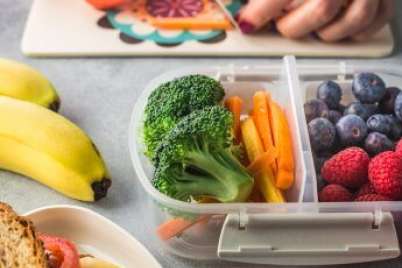
5 tips to help kids build a healthy relationship with food
As a dietitian in Public Health, I hear many stories about food-related issues in the community.
A co-worker came to me the other day to tell me a story about her son in Grade Two. He was receiving marshmallows for being good, helpful, or getting his work done in class. She wanted to know what I thought of that. I think it brings up a good point about food environments and how helpful, or not helpful, they can be.
Children learn about what, when, and how to eat at home, at school, and at play in the community. The food and how it’s offered in these settings dictates what children learn to prefer or what they think is “cool” to consume. We call these “food environments” and they often teach our kids to prefer less nutritious foods.
An average week for a school-aged child may look something like this (from It Takes a Village module # 5):
Guest post by Kathryn Forsyth
Kathryn Forsyth is a wife, mother of two teenage boys, and a Public Health Dietitian with the Grey Bruce Health Unit. She is currently co-chair of the Healthy Eating in Recreation Settings provincial workgroup with the Ontario Society of Nutrition Professionals in Public Health.
– Monday: classmate’s birthday — parent sends donuts
– Tuesday: house league soccer win — coach hands out freezies
– Wednesday: community concert — bake sale fundraiser
– Thursday: after-school program activity — baking cookies
– Friday: Valentine’s Day party — teacher gives out candy hearts
Each little treat may not seem like a big deal on its own. When taken as a whole, they are not “treats” at all, but rather a very common occurrence for most children. And one that often adds excess calories from non-nutritious foods and beverages.
Children need all the adults in their lives to support healthy eating and active living through both actions and words. This helps to build healthy habits for life. There is a special role for educators, coaches, and recreation leaders to advocate for healthy food environments for the children in their care. Parents play a huge role in this, too. For instance, there are several health benefits of sauerkraut so you might want to incorporate it into your kid’s diet or find recipes with sauerkraut that your kid will like.
Consider these five tips to help children build healthy relationships with food:
1. Do not use food or sugar-sweetened beverages as a reward — this can lead to emotional responses to food and create much bigger problems later in life, including disordered eating. Early food experiences are key to establishing healthy eating habits for a lifetime.
2. Try non-food rewards such as more outdoor playtime, a new game, activity, or craft. Let’s reconsider the week of examples where treats were provided. Parents may not be in charge of all these situations but they can have a voice. Join your school’s parent council, help coach a team, ask your children what they have had for a snack, and make sure you offer healthy choices to balance out the day. Here are some of the non-food suggestions from the module — along with a few more:
– Monday: sing Happy Birthday to the student
– Tuesday: make a high-five tunnel and have everyone run through it, twice
– Wednesday: raffle off donated sports equipment or musical instruments
– Thursday: make hummus and use fresh vegetables for dipping
– Friday: make red fruit kabobs or wear your favourite red piece of clothing
3. Be a good role model yourself. Take this as an opportunity to improve your own eating and activity habits. Follow Canada’s Food Guide and choose foods that come from a food group, not a crinkly package.
4. Remember: Children are always watching and listening. Be mindful of how you speak about food and body image. When describing other people, try not to comment on their looks or size. Be “non-looks” focused. Take time to listen to your child. Do not ignore or dismiss their feelings. Mental health is closely tied to physical health. If you are concerned about disordered eating or an eating disorder, www.nedic.ca may be a good resource for you.
5. Plan a week of healthy menus with your children using the meal planner tool from www.eatrightontario.ca and download the Dietitians of Canada free app, Cookspiration for new and creative recipes at your fingertips. And be sure to have your children help you prepare these recipes!
It will take a concerted effort by all of society to start changing and improving the food environments for our children. That change can start small and it can start with you. Think about which one of the five tips in this article you could work on and start today.





